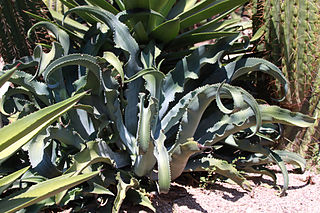
San Marino is located in Southern Europe, an enclave (landlocked) in central Italy, which it borders for 39 km. The third smallest independent state by area in Europe after the Vatican City and Monaco, San Marino is dominated by the Apennines. Located at 43.94°N 12.46°E, it covers an area of 61.2 km2 (23.6 sq mi). Completely mountainous, only 17% of its territory is arable. Several rivers flow through the country, the largest being the Ausa, the Marano, and the San Marino River.

Haworthia is a large genus of small succulent plants endemic to Southern Africa (Mozambique, Namibia, Lesotho, Eswatini and South Africa).

An IUCN Red List Critically Endangered species is one that has been categorized by the International Union for Conservation of Nature as facing an extremely high risk of extinction in the wild. As of December 2023, of the 157,190 species currently on the IUCN Red List, 9,760 of those are listed as Critically Endangered, with 1,302 being possibly extinct and 67 possibly extinct in the wild.

Delonix pumila is a species of flowering plant in the family Fabaceae. It is endemic to Madagascar.
Actinodaphne lawsonii is a species of plant in the family Lauraceae. It is endemic to the Western Ghats of southern India. It is threatened by habitat loss.

Astroloba rubriflora is a succulent plant found in the mountainous Karoo area around Robertson, South Africa. It is listed as a Vulnerable species on the IUCN global Red List.

A vulnerable species is a species which has been categorized by the International Union for Conservation of Nature as being threatened with extinction unless the circumstances that are threatening its survival and reproduction improve.

Aloe brevifolia, the short-leaved aloe, is a species of flowering plant in the family Asphodelaceae. It is a tiny, compact, blue-green evergreen succulent perennial, that is native to the Western Cape, South Africa. Listed as Endangered on SANBI's Red List, it is threatened in its natural habitat, but is also widely popular as an ornamental plant in rockeries and desert gardens worldwide.

The North-West University Botanical Garden on the Potchefstroom Campus of the North-West University (NWU) is the only botanical garden in the North West Province of South Africa. The Garden spans just under three hectares and is open to the public.

Haworthiopsis attenuata, formerly Haworthia attenuata, commonly known as zebra haworthia, is a small species of succulent plant from the Eastern Cape Province, South Africa. As an ornamental, it is one of the most commonly cultivated of the Haworthiopsis species.
Abronia fimbriata is a species of lizard endemic to the mountains of east-central Guatemala, including Sierra de Xucaneb, Sierra de las Minas, Sierra de Chuacús and Sierra de los Cuchumatanes, and is found in the cloud forests at elevations of 1,400–2,100 m. Its extent of occurrence is estimated to be only 1,500 km2, and is considered to be endangered.

Haworthia retusa is a species of flowering plants of the genus Haworthia in the family Asphodelaceae, endemic to a very small area around Riversdale, in the Western Cape Province in South Africa. Growing to 10 cm (3.9 in) tall and broad, it is a perennial succulent with thick triangular leaves and small white tubular flowers held in 50 cm (20 in) tall racemes.

Haworthiopsis pungens, formerly Haworthia pungens, is a species of flowering succulent plant from the Eastern Cape Province, South Africa.

Tulista kingiana is a species of succulent plant, from the Western Cape, South Africa. It is listed as Endangered on the IUCN global Red List.

Tulista marginata is a species of Tulista succulent plant, from the Western Cape, South Africa.

Endangered species, as classified by the International Union for Conservation of Nature (IUCN), are species which have been categorized as very likely to become extinct in their known native ranges in the near future. On the IUCN Red List, endangered is the second-most severe conservation status for wild populations in the IUCN's schema after critically endangered. In 2012, the IUCN Red List featured 3,079 animal and 2,655 plant species as endangered worldwide. The figures for 1998 were 1,102 and 1,197 respectively.

Agave gypsophila is a species of plant in the Asparagaceae family and is endemic to the Mexican state of Guerrero. The specific epithet, gypsophila, means gypsum loving.

Uvariopsis dicaprio is a species of tropical evergreen tree in the genus Uvariopsis. It is endemic to the Ebo Forest, in the Littoral Region of Cameroon. It was the first new plant species described in 2022, and was named after American actor Leonardo DiCaprio by botanists Martin Cheek and George Gosline, from the Royal Botanic Gardens, Kew. U. dicaprio is classified as Critically Endangered in the IUCN Red List.
Aloe lettyae is a species of aloe endemic to the Woodbush Granite Grassland in the Haenertsburg Nature Reserve in the Limpopo Province, South Africa. It is endangered species, prone to fires and introduction of foreign species for economical reasons. They have become a face for this highly threatened area lacking in proper research for various ecological reasons.

Hernandia voyronii, commonly known as Hazomalany, is a species of plant in the Hernandiaceae family. It is endemic to Madagascar.
















